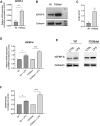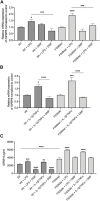Insulin-Like Growth Factor Binding Protein (IGFBP-6) as a Novel Regulator of Inflammatory Response in Cystic Fibrosis Airway Cells
- PMID: 35903151
- PMCID: PMC9322660
- DOI: 10.3389/fmolb.2022.905468
Insulin-Like Growth Factor Binding Protein (IGFBP-6) as a Novel Regulator of Inflammatory Response in Cystic Fibrosis Airway Cells
Abstract
Cystic Fibrosis (CF) patients are prone to contracting bacterial lung infections with opportunistic pathogens, especially Pseudomonas aeruginosa. Prolonged P. aeruginosa infections have been linked to chronic inflammation in the CF lung, whose hallmarks are increased levels of cytokines (i.e., TNF-α, IL-1β, IL-6) and neutrophil attraction by chemokines, like IL-8. Recently, insulin-like growth factor binding protein 6 (IGFBP-6) has been shown to play a putative role in the immune system and was found at higher levels in the sera and synovial tissue of rheumatoid arthritis patients. Moreover, it has been demonstrated that IGFBP-6 has chemoattractant properties towards cells of the innate (neutrophils, monocytes) and adaptive (T cells) immunity. However, it is not known whether IGFBP-6 expression is dysregulated in airway epithelial cells under infection/inflammatory conditions. Therefore, we first measured the basal IGFBP-6 mRNA and protein levels in bronchial epithelial cells lines (Wt and F508del-CFTR CFBE), finding they both are upregulated in F508del-CFTR CFBE cells. Interestingly, LPS and IL-1β+TNFα treatments increased the IGFBP-6 mRNA level, that was reduced after treatment with an anti-inflammatory (Dimethyl Fumarate) in CFBE cell line and in patient-derived nasal epithelial cultures. Lastly, we demonstrated that IGFBP-6 reduced the level of pro-inflammatory cytokines in both CFBE and primary nasal epithelial cells, without affecting rescued CFTR expression and function. The addition of a neutralizing antibody to IGFBP-6 increased pro-inflammatory cytokines expression under challenge with LPS. Together, these data suggest that IGFBP-6 may play a direct role in the CF-associated inflammation.
Keywords: IGFBP-6; TRIKAFTA; airway epithelial cells; cystic fibrosis; cytokine; dimethyl fumarate.
Copyright © 2022 Laselva, Criscione, Allegretta, Di Gioia, Liso and Conese.
Conflict of interest statement
The authors declare that the research was conducted in the absence of any commercial or financial relationships that could be construed as a potential conflict of interest.
Figures




Similar articles
-
Does the F508-CFTR mutation induce a proinflammatory response in human airway epithelial cells?Am J Physiol Lung Cell Mol Physiol. 2012 Sep 15;303(6):L509-18. doi: 10.1152/ajplung.00226.2011. Epub 2012 Jul 20. Am J Physiol Lung Cell Mol Physiol. 2012. PMID: 22821996 Free PMC article.
-
Enhanced Expression of Human Epididymis Protein 4 (HE4) Reflecting Pro-Inflammatory Status Is Regulated by CFTR in Cystic Fibrosis Bronchial Epithelial Cells.Front Pharmacol. 2021 May 14;12:592184. doi: 10.3389/fphar.2021.592184. eCollection 2021. Front Pharmacol. 2021. PMID: 34054511 Free PMC article.
-
Anti-Inflammatory and Anti-Oxidant Effect of Dimethyl Fumarate in Cystic Fibrosis Bronchial Epithelial Cells.Cells. 2021 Aug 19;10(8):2132. doi: 10.3390/cells10082132. Cells. 2021. PMID: 34440900 Free PMC article.
-
[Early bronchial inflammation in cystic fibrosis].J Soc Biol. 2002;196(1):29-35. J Soc Biol. 2002. PMID: 12134630 Review. French.
-
Harnessing Neutrophil Survival Mechanisms during Chronic Infection by Pseudomonas aeruginosa: Novel Therapeutic Targets to Dampen Inflammation in Cystic Fibrosis.Front Cell Infect Microbiol. 2017 Jun 30;7:243. doi: 10.3389/fcimb.2017.00243. eCollection 2017. Front Cell Infect Microbiol. 2017. PMID: 28713772 Free PMC article. Review.
Cited by
-
Olive Leaf Extract (OLE) as a Novel Antioxidant That Ameliorates the Inflammatory Response in Cystic Fibrosis.Cells. 2023 Jul 1;12(13):1764. doi: 10.3390/cells12131764. Cells. 2023. PMID: 37443798 Free PMC article.
-
New TMA (4,6,4'-Trimethyl angelicin) Analogues as Anti-Inflammatory Agents in the Treatment of Cystic Fibrosis Lung Disease.Int J Mol Sci. 2022 Nov 21;23(22):14483. doi: 10.3390/ijms232214483. Int J Mol Sci. 2022. PMID: 36430961 Free PMC article.
-
IGFBP-6 Network in Chronic Inflammatory Airway Diseases and Lung Tumor Progression.Int J Mol Sci. 2023 Mar 2;24(5):4804. doi: 10.3390/ijms24054804. Int J Mol Sci. 2023. PMID: 36902237 Free PMC article. Review.
-
Deleterious effect of Pseudomonas aeruginosa on F508del-CFTR rescued by elexacaftor/tezacaftor/ivacaftor is clinical strain-dependent in patient-derived nasal cells.ERJ Open Res. 2025 May 27;11(3):00970-2024. doi: 10.1183/23120541.00970-2024. eCollection 2025 May. ERJ Open Res. 2025. PMID: 40432819 Free PMC article.
-
The Oncogenic Theory of Preeclampsia: Is Amniotic Mesenchymal Stem Cells-Derived PLAC1 Involved?Int J Mol Sci. 2023 Feb 10;24(4):3612. doi: 10.3390/ijms24043612. Int J Mol Sci. 2023. PMID: 36835024 Free PMC article.
References
-
- Abbattiscianni A. C., Favia M., Mancini M. T., Cardone R. A., Guerra L., Monterisi S., et al. (2016). Correctors of Mutant CFTR Enhance Subcortical cAMP-PKA Signaling through Modulating Ezrin Phosphorylation and Cytoskeleton Organization. J. Cell Sci. 129, 1128–1140. 10.1242/jcs.177907 - DOI - PubMed
-
- Broxmeyer H. E., Sherry B., Cooper S., Lu L., Maze R., Beckmann M. P., et al. (1993). Comparative Analysis of the Human Macrophage Inflammatory Protein Family of Cytokines (Chemokines) on Proliferation of Human Myeloid Progenitor Cells. Interacting Effects Involving Suppression, Synergistic Suppression, and Blocking of Suppression. J. Immunol. 150, 3448–3458. - PubMed
LinkOut - more resources
Full Text Sources
Miscellaneous

